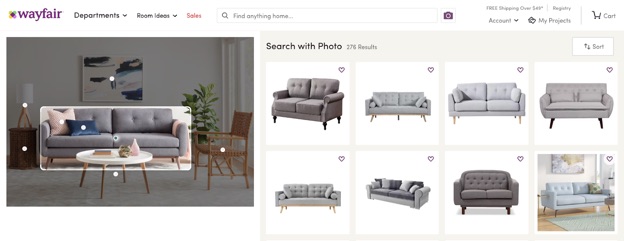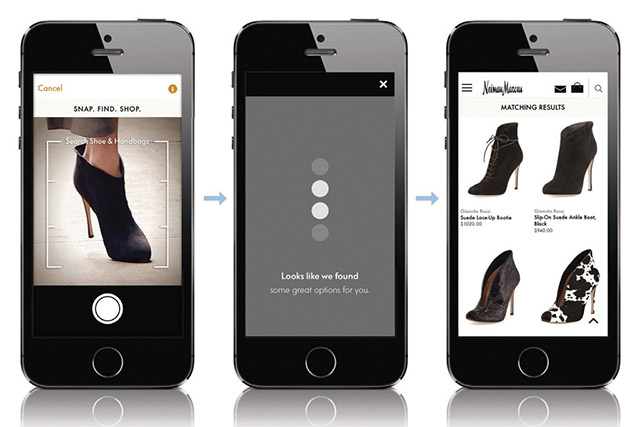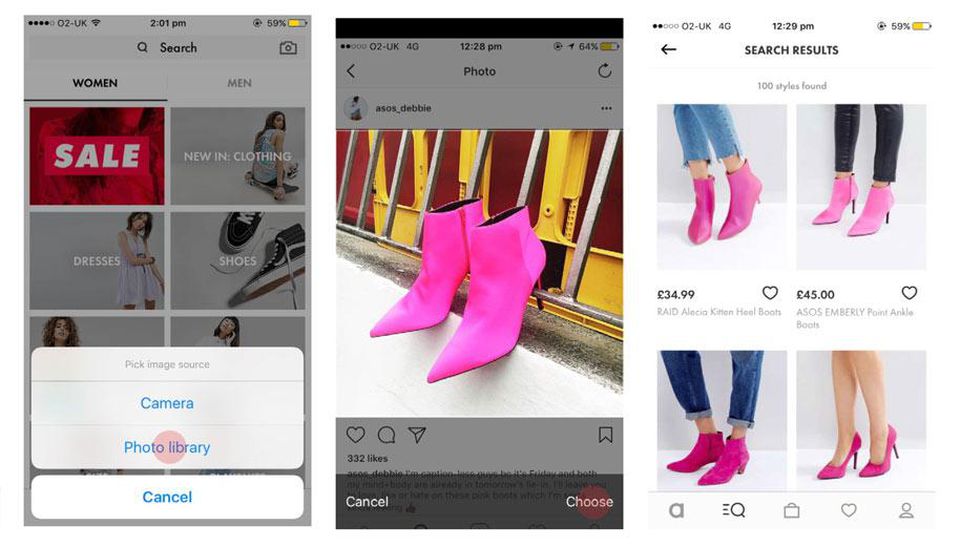- How brands are using visual search to optimize customer experiences.
- What is Visual Search?
- How Visual Search Works
- What Businesses Can Benefit Most?
- How to Successfully Use Visual Search
- How to Optimize Content for Visual Search Engines
- Four of the Best Examples of Companies Using Visual Search to Engage Customers and Improve Online Experiences
- Integrate Online and Offline Worlds to Create Richer Customer Search Experiences
- Download 8 Trends to Grow Your Global Online Sales in 2021
How brands are using visual search to optimize customer experiences.
What is Visual Search?
Visual search allows people to search using images as opposed to text. With a photograph that they have taken, or found online or on social media, consumers can search to find the same item or something similar. Software identifies what the object is in the picture and returns results based on the image. From online to onsite to live streaming, retailers that harness the potential of visual search can grow their online revenue.
How Visual Search Works
Visual search uses a combination of computer image processing to interpret the image and machine learning technology to understand what is being presented. When applied in a search function, this information is cross-referenced with image recognition technology to deliver matches or results. GenZ and millennials have a strong preference for visual search (62%) (ViSenze) and research shows that brands supporting visual search will increase their revenue from digital commerce by 30% in 2021. (Gartner)
Visual search can help retailers provide an easier and more efficient shopping experience for customers – closing the gap between search and purchase. When a customer sees something they like and want to know more about it or even purchase it, all they need is a picture. They can snap a photo of the item wherever they see it, when they are out and about, browsing online, scrolling through their social media stream or flicking through a magazine. The image can then be used to find the item or something similar on your website.
What Businesses Can Benefit Most?
Retailers in fashion, home decor and beauty have been quick to adopt visual search. Any digital retailer or marketplace can benefit, especially retailers that have a large selection of products with names customers may not know or that are difficult to describe. B2B organization in industrial manufacturing can also benefit by enabling customers to quickly identify parts and components
How to Successfully Use Visual Search
Offering greater personalization and driving omnichannel experiences, visual search incorporates many of the key trends driving ecommerce growth. Many of the existing platforms used by both shoppers (to find what they are looking for) and retailers (to promote their products) have invested to develop visual search. This creates an opportunity for brands to increase their visibility in highly competitive and noisy marketplaces and shoppers to search online using real-world images.
1. Integrate Visual Search into Your Sites and Apps
- Companies like Shopix offer AI-based visual search engines for existing ecommerce websites, allowing smaller merchants to build customized and scalable visual search engines into their sites.
2. Leverage Existing Search Engines
- The Google Visual Search engine is Google Lens. It allows users to find the items they are looking for without having to type in a description. Google Lens technology is available to Android users in Photos, Google Search, and Google Assistant.
- Pinterest Visual Search is called Pinterest Lens allows users to point their cameras towards any item they want to search on Pinterest for, once the item is within the circle, the search is initiated by taking a photo. Users can also upload any existing photos they have saved to their camera roll.
- Amazon’s StyleSnap visual search app works with Instagram Visual Search functionality to allow shoppers to take pictures within the Amazon mobile app to search for similar products that are available in the Amazon store.
- To create shoppable Instagram and Facebook posts, retailers need to ensure that they have business accounts on each platform. For Facebook, this translates into having a Facebook Page as opposed to a profile and for Instagram having a business account.
How to Optimize Content for Visual Search Engines
As in any search optimization, the best practices for site performance are essential, including site speed and accessibility. Using a Visual Search Technology Platform as a marketing tool requires some additional considerations to see the best results.
- Image titles: use relevant keywords and precision to ensure the best results.
- Alt-text: replaces an image if it can not be uploaded and is used by search engines to understand what the image is and how to rank it.
- Image descriptions: provide greater context into the image and should include keywords.
- Image format: impacts loading speed and image quality. The dimensions of an image should be kept to within desktop screen resolution and optimized for specific platforms.
An image sitemap: required for Google to identify, crawl, and index the images and ensures the images can be found by search engines.
Four of the Best Examples of Companies Using Visual Search to Engage Customers and Improve Online Experiences
Wayfair
Search helps users to discover the products they are looking for among the millions offered by Wayfair. Text search could only work to a certain extent as it is difficult to describe these items in a way that a search engine understands.
With Wayfair’s Visual Search, customers can use photos of items they like to find products that are visually similar on the Wayfair website. The earlier version of this search function required the customer to ensure the photos were tightly cropped to the object of interest. The latest version allows customers to select areas of their photos for search that include multiple products. This upgrade resulted in a 58% increase in repeat engagement. (Wayfair)

Home Depot
Home Depot has made strategic investments to seamlessly blend digital and physical experiences to create frictionless omnichannel shopping. Visual search is a core component of this strategy and uses technology to provide shoppers with recommendations based on the photo used during the search and making it easy for the customer to find the item they are looking for.
With more than one million items in stock, visual search not only saves time, it also increases customer engagement. Following the introduction of these digital initiatives, Home Depot’s ecommerce sales increased by 20% in comparison to an increase of 5.2% for in-store sales. (Indigo9 Digital)

Neiman Marcus
For its mobile app, Neiman Marcus launched a feature called Snap. Find. Shop. Customers can upload a photo to see if it or something similar is in the store’s online inventory. If an exact match is made, it is returned, but if not, similar products are presented. The app has increased app usage and customer engagement.

Asos
Asos introduced Style Match through their mobile web app to allow customers to upload photos from their own library, magazines or social media to the app to search for the same or similar products in the Asos catalog. The results help customers to find the items they are looking for quickly and easily.

Integrate Online and Offline Worlds to Create Richer Customer Search Experiences
Providing customers with a visual search tool in an app or on a website offers convenience to the shopper and tailors the results to items only offered by the retailer. Without significant investment, all retailers can leverage visual search engines such as Pinterest Lens to see firsthand how the technology enhances their customers’ experience, improves the visibility of their own products online and increases sales.
Download 8 Trends to Grow Your Global Online Sales in 2021
Learn about the emerging trends that can develop markets, increase revenue and optimize your customers’ experiences, plus get actionable steps to put each trend to work in your ecommerce platform.
Choose Your eCommerce Platform to Download the Guide:
WooCommerce, Shopify, Wix, Magento
Subscribe Via Email
Thank You!
You’ve Been Subscribed.



